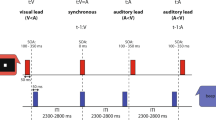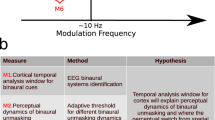Abstract
It has recently become evident that sensory thresholds for certain tasks are lower than those expected from the properties of individual receptors1. This perceptual capacity, termed hyperacuity, reveals the impressive information-processing abilities of the central nervous system. Although much is known about spatial hyperacuity, temporal hyperacuity has received little attention2. Here we demonstrate that an electric fish, Eigenmannia, can detect modulations in the timing (phase) of an electrical signal at least as small as 400 ns. Such sensitivity exceeds the temporal resolution of individual phase-coding afferents. This hyperacuity results from a nonlinear convergence of parallel afferent inputs to the central nervous system; subthreshold inputs from particular areas of the body surface accumulate to permit the detection of these extremely small temporal modulations.
This is a preview of subscription content, access via your institution
Access options
Subscribe to this journal
Receive 51 print issues and online access
$199.00 per year
only $3.90 per issue
Buy this article
- Purchase on Springer Link
- Instant access to full article PDF
Prices may be subject to local taxes which are calculated during checkout
Similar content being viewed by others
References
Westheimer, G. Invest. Ophthal. vis. Sci. 18, 893–912 (1979).
Simmons, J. Science 204, 1336–1338 (1979).
Bullock, T. H., Hamstra, R. H. & Scheich, H. J. comp. Physiol. 77, 1–48 (1972).
Heiligenberg, W. & Altes, R. Science 199, 1001–1004 (1979).
Hopkins, C. Science 212, 85–87 (1981).
Heiligenberg, W., Baker, C. & Matsubara, J. J. comp. Physiol. 127, 267–286 (1978).
Heiligenberg, W. & Bastian, J. J. comp. Physiol 136, 113–133 (1980).
Carr, C. E., Heiligenberg, W. & Rose, G. J. Neurosci. (in the press).
Heiligenberg, W. & Rose, G. J. Neurosci. 5, 515–531 (1985).
Konishi, M., Sullivan, E. & Takahashi, T. J. acoust. Soc. Am. 78(1), 360–364 (1985).
Zwislocki, J. & Feldman, R. S. J. acoust. Soc. Am. 28, 860–864 (1956).
Westheimer, G. Prog. Sensory Physiol. 1, 1–30 (1981).
Author information
Authors and Affiliations
Rights and permissions
About this article
Cite this article
Rose, G., Heiligenberg, W. Temporal hyperacuity in the electric sense of fish. Nature 318, 178–180 (1985). https://doi.org/10.1038/318178a0
Received:
Accepted:
Issue Date:
DOI: https://doi.org/10.1038/318178a0
This article is cited by
-
Time disparity sensitive behavior and its neural substrates of a pulse-type gymnotiform electric fish, Brachyhypopomus gauderio
Journal of Comparative Physiology A (2013)
-
Behavioral responses to jamming and ‘phantom’ jamming stimuli in the weakly electric fish Eigenmannia
Journal of Comparative Physiology A (2007)
-
Encoding and processing biologically relevant temporal information in electrosensory systems
Journal of Comparative Physiology A (2006)
-
Walter Heiligenberg: the jamming avoidance response and beyond
Journal of Comparative Physiology A (2006)
-
Spike coding from the perspective of a neurone
Cognitive Processing (2005)
Comments
By submitting a comment you agree to abide by our Terms and Community Guidelines. If you find something abusive or that does not comply with our terms or guidelines please flag it as inappropriate.



